This is a detailed comparison of Near Field Vs Far Field Studio Monitors. I have researched a lot before writing this comparison. If you are confused between these two terms then you should read this article.
Near-Field and Far-field are very important terms in audio recording. These terms are used with studio monitors. In this article, we’ll learn what are near-field and far-field studio monitors and their application in audio recording.
I will also describe here the full knowledge of the near-field and far-field studio monitors and which one will work better in your studio.
All these things are included in this article.
So keep reading…
Table of Contents
Near Field Vs Far Field Studio Monitors
In the sound technology, “Active Field” is derived as the AREA under which the sound doesn’t damp down. After that “Active Field” area, the sound starts damping. In any speaker system, after a certain distance, the sound is started damping. This distance is referred to as the “Field” of that speaker system.
I think you understood the term field. Now it’s time to gain some knowledge of the different types of Fields.
Disclosure: This post may contain affiliate links, which means we may receive a commission if you click a link and purchase something that we recommended. Read more about Affiliate disclosure here.
There are 3 types of fields in speaker mechanics.
- Near-field
- Mid-field
- Far-field
The range of the field is directly proportional to the size of the driver. The size of your monitor’s driver decides whether the speaker is a near field, midfield, or far-field.
As this article is a comparison between the near field vs far field, we will only discuss these two terms here.
Other helpful articles related to Studio Monitors
- 10 Best Studio Monitors Under $1000 [2024 List]
- Studio Monitors Vs Speakers | Difference Between Monitors and Speakers
First, let us know…
What is a nearfield Studio Monitor?
Near-field monitors are generally made of 2 speakers.
- Woofer (Driver)
- Tweeter
As I have told above, the size of the driver decides the type of field in a monitor. Like near-field drivers generally come in small sizes from 3″ to 8″. In near-field monitors, the “active field” falls under 3-5 feet. This distance is identical for desktop placement.
Now let us see some advantages of near field monitors.
Advantage 1
Every authority in the recording field said that near-field monitors are ideal for song mixing. Do you know why?
Because in near-field monitors, you will replicate the effect of the normal speakers which are widely used in transport, lifts, computer desktops, small rooms, etc.
If you mix your songs with near-field monitors then you can perfectly balance the lower high and higher low frequencies, which are the most important frequencies in the human audible range. You should know that the human vocal also falls in this range.
Due to this advantage, near-field monitors are widely used in the home as well as professional studios.
Advantage 2
The second advantage of near-field monitors is as they have a small driver size, they don’t produce extremely low frequencies, especially below 45Hz which is good for your health.
As well as they don’t produce a high-intensity sound which could reflect from your studio walls and ruin your mixing. For a recordist, his ears are the most important organ of his body.
Nobody wants to lose their hearing by continuously working in an environment full of noise.
Here near-field monitors help you a lot.
What is a far-field Studio Monitor?
Far-field monitors have 2 to 3 speakers.
- Low range driver
- Mid-range driver
- Tweeter
I have mentioned here it does not mean that a far-field monitor must have a midrange driver. Many far-field monitors don’t have a mid-range drive.
Here are the features of Far-Field monitors that separate them from Near-field.
- Far-Field monitors generally come above 7″ in driver size.
- The sound they produce is not acceptable for small studious. As, they have big driver size, they produce high sound levels which creates a much amount of reflection in the small studios and interrupt the original sound. So, they are not ideal for small size studios.
- Their sound starts to damp after 6 feet. Do you want to be at the front of the speakers which could ruin your listening power? You can’t use them on or just behind your recording table.
- The low frequency could go as low as 15Hz which is under the audible range of human ears. The huge amount of bass reflections cause a bad quality mixing.
If you want a perfect acoustic treatment for your home studio UNDER YOUR BUDGET then this guide will help you.
Well, back to the topic, I know you are curious about if far-field monitors are not used in studios then where is the application of these types of speakers?
The purpose of using far-field monitors
I think you are aware of extremely low-frequency bass sound in movie theaters, especially when an action scene is going on.
Far-field and midfield studio monitors are used in professional film and background studios. In film scoring, you have to create a virtual environment in the scene which requires real-life sound too.
Without Far-field monitors, it’s never been possible to create real-life situations in a theatre.
So, here you went through some of the features, advantages, and disadvantages of near-field and far-field monitors.
Now it’s time to go some deep within. Keep reading as this is the ultimate guide to this concept and helps you to choose the best pair of studio monitors for your recording studio.
Difference Between Near field Vs Far-field Studio monitors
In the above section, you’ve read about what are near-field and far-field monitors. Now it’s time to look into the difference between them.
Dynamic Range
For a studio monitor, dynamic range plays a very important role. It is considered one of the pillars of the good mixing process.
If your monitor has a good dynamic range you can deliver a good mix. Dynamic range is the difference between the largest and smallest point of the audio signal in the frequency graph produced by the audio monitor.
Suppose you have a soundtrack which as you know is a mixture of sound frequencies. Now consider, at a certain time period the frequency graph shows the bunch of sound frequencies which includes the highest intensity sound as well as the lowest intensity sound.
Let us consider in the music track,
- The lowest intensity sound = -20dB
- The highest intensity sound = -2dB
- Then the dynamic range of this music = 20dB – 2dB = 18dB
This image will explain that to you.
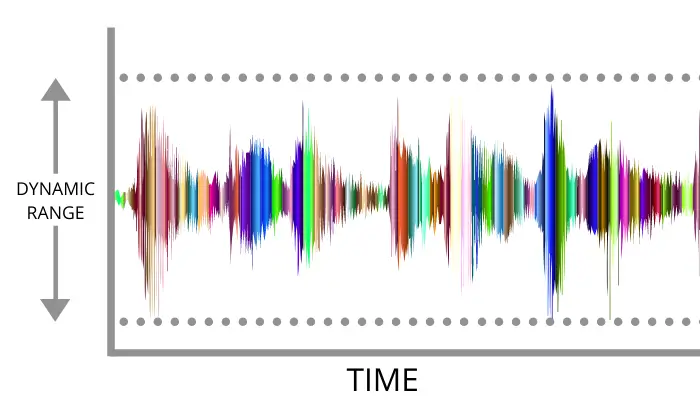
A speaker has a dynamic range to produce certain frequencies. The more dynamic range your monitor has the more accurate mix you can deliver.
DO YOU KNOW WHY?
When you mix music, your aim is to balance the low-intensity sounds with the high-intensity sound as anyone can listen to that low-intensity sounds along with high-intensity sounds.
Balancing low and high-intensity sounds in an audible range are called perfect mixing.
A dynamically rich monitor speaker produces high and low-intensity sound clearly as you could mix them perfectly.
In Far-field monitors, the dynamic range is usually low which is helpful to monitor from distance but it is not ideal for small studios where space is limited.
On the other hand, nearfield monitors perform well in home studios as they have dynamically rich drivers and tweeters.
Headroom
I have thoroughly described Headroom in my other post How To Choose Studio Monitors For Home Studio [Ultimate Guide] So, I am not going deep here. but here is the quick brief on the Headroom.
Every studio monitor system is capable to handle signals up to a particular range which is called the nominal signal handling level of that monitor.
Manufacturers reserve a few extra dB above this nominal signal handling level which is called a safety zone and allows transient audio peaks to exceed the nominal level without damaging the system or the audio signal.
This safety zone is called the Headroom.
See this image
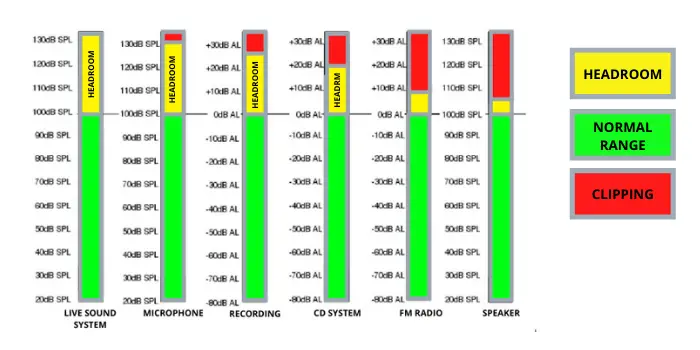
I think you are now aware of the Headroom.
This is the second pillar of perfect mixing. But the headroom does not do many effects on near-field and far-field monitors.
Do you want some good articles on audio mixing? checkout,
- What is Summing in Audio Mixing and Why Should You Know About it
- What is Mixing Console or Mixer [Ultimate Guide]
Because the headroom is important for both types of monitors, it has more or less headroom either it is far-field or near-field.
Frequency range
Just opposite to the headroom, the frequency response is an important factor used to divide both the monitor types.
Near-field studio monitors are unable to produce sounds below 45dB frequency but because of the big driver size, far-field monitors are capable to do this. They can produce sound up to below 20Hz which is the lowest barrier of audible range of human ears.
The low-frequency coverage is the biggest reason for using far-field monitors in film studios.
On the other hand, the near-field monitor does not produce sounds lower than 45Hz but is ideal for music mixing.
Crossover Frequency
The crossover frequency is another factor that differs both the monitor types.
If you don’t know what is crossover frequency here I am going to describe it.
First, see the image below.
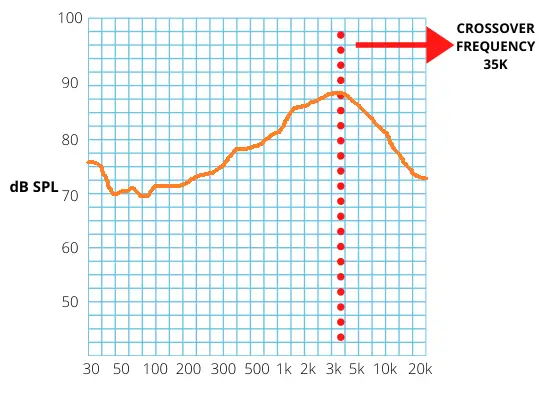
A monitor produces the most intensity of sound at a certain frequency range. This frequency range is called the Crossover frequency. A monitor is most active at that particular frequency range.
Every monitor set has a different crossover frequency and this crossover frequency decides the main work of that monitor system.
Near-field monitors are most active at lover mid to higher midrange (600Hz-3500Hz) depending on the driver and make of the monitor.
However, Far-field monitors are also active in the mid-frequency range but they also have a secondary crossover frequency at a low range around 100Hz – 600Hz.
This feature differs far-field monitors from the near-fields.
This is not an ideal mixing condition for music but is very helpful in scoring.
We need this feature in our monitors to create a virtual environment in the movie.
Wattage
In Far-field monitors, bigger size drivers are used so they need more power. More power also needs high wattage amps that would deliver a huge amount of sound which your small home studio can’t handle.
Near-field monitors have small drivers. They don’t need more powerful amps to produce the sound. The wattage normally ranges between 15W-100W which is quite sufficient for home recording studios.
Placement
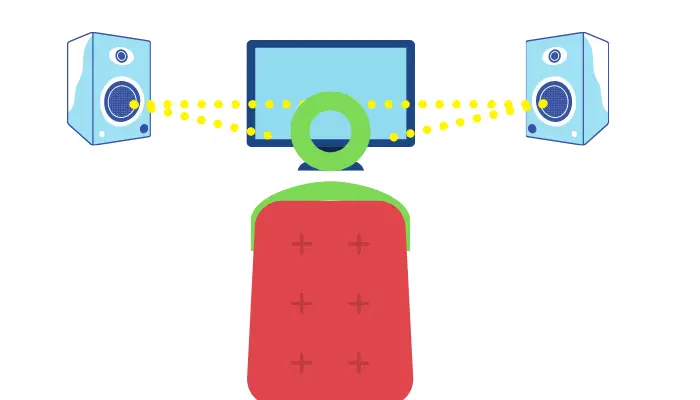
We can’t place far-field monitors just a few feet away from our ears. They have a bigger active field area, usually more than 6 feet. So, if you place them near your ears, probably you would lose your hearing capacity.
Far-field monitors need a big size control room with heavy acoustic treatment. If you use these monitors in an ordinary home studio’s control room, you’ll get a lot of reflection that will ruin your mixing.
Near-field studio monitors are just the opposite. You can use them with any room size. The only requirement is to place them close to your ears.
Acoustic Treatment of Room
Heavy acoustic treatment also needs a huge amount of money that a home studio owner can’t afford.
Hollywood and other big studios are capable of bearing this big amount of investment, so Farfield monitors are used in these studios only.
Near-field monitors don’t require a heavy acoustic treatment. As their active field are not more than 5 feet so they don’t impact the wall more. The reflections are minimum so you can mix in a partially acoustic room too.
The Use of Near Field Monitors
Small recordists mostly use nearfield monitors as they are the best fit for home and small studios. Near-field monitors are ideal for home studios as there is the minimum impact of the environment on the mixing.
The Use of Far-Field Monitors
Far-field monitors are used by big studios who have a bigger space, heavy acoustic treated room and their main work is sound effects and background scoring. They are not ideal for home studios.
Conclusion
Now I think you have a better angle of view for both kinds of monitors. I have tested both the monitors in my studio. As usual near-field monitors worked well in my studio.
I am using a near-field monitor for a while and am satisfied with this. I have used Alesis M1active 5″ monitor, Yamaha AV42 monitor and now have a pair of Yamaha HS8 pairs and am satisfied with it.
Now the choice is yours. To compare nearfield monitors in your price range just go to this article.
If you have a query on this article feel free to drop a comment right below and share this article in your social circle as your fellow recordists could read this.
Read also,

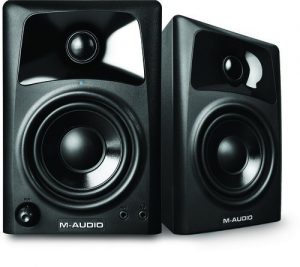
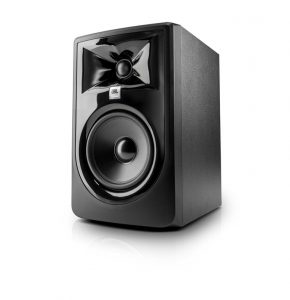

![Heritage Audio i73 PRO Series Audio Interfaces Review [2024]](https://www.recordingbase.com/wp-content/uploads/2024/01/Heritage-Audio-i73-pro-series.jpg)

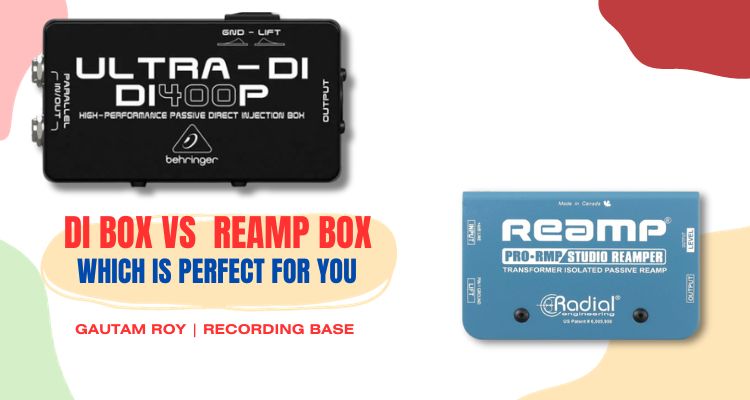


I’m wondering why a narrow dynamic range is good for far field monitors?
Thanks
Far field monitors are able to reproduce sounds that don’t loose their intensity at a much greater distance than near field monitors. To achieve this they must reproduce very loud sounds, that stay loud over a longer distance. I think because of the way speakers have to be built in order to deliver so much volume, they can’t reproduce quiet sounds as accurately as near field monitors can. The difference would be marginal, but it’s all about the details. I think that is what is meant by “having a lower dynamic range”. It’s a side effect that makes far field monitors not good for quiet listening sessions.